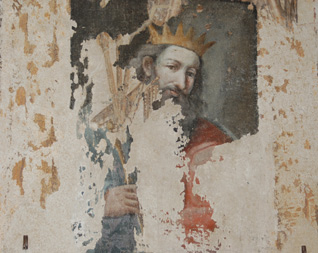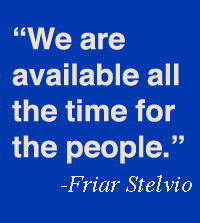By Claire Davis

At the age of 22, an architect met a woman who would
ultimately change the course of his life. Though the woman had cancer,
she radiated life.
“Even
though she was sick for four years, she was so serene; she had hope,”
says Friar Stelvio, who credits the woman with helping him find his path
to the Franciscans. “She became a teacher for me and a beacon of
light.”
To this day, Friar Stelvio thinks of her to find strength
and hope.
Friar Stelvio is now the provincial at the Monastero
Dei Cappucini, a Franciscan-Capuchin monastery in Cagli, Italy. The ancient
buildings where he and two other friars reside are nestled in the lush
hills above the city. It is a sanctuary and safe place for the people
of Cagli.
“We are available all the time for the people,”
says Friar Stelvio.
Friar Stelvio was born in Camerino, Italy. He studied
theology and philosophy in Rome before returning to the Marche region
and the Capuchin monastery where he now lives. The Monastero Dei Cappucini
is one of 20 monasteries
in the Marche region. It is currently under the Franciscan order, although
it has not always been this way.
 The Benedictines founded Monastero Dei Cappucini in 1481.
It then became a thriving fortress during times of war.
Reminiscences
of those violent times remain forever emblazoned in the walls that surround
the monastery and the crumbling structure that overlooks Cagli. These
ruins are a reminder that Cagli was not always as peaceful as it is now.
Much of the monastery has been renovated, although there
is one room that remains intact from the original construction. To this
day the friars of Monastero Dei Cappucini eat in the dining room where
the Benedictines once broke bread and drank wine. The old wooden tables
and benches and beautiful, paint-chipped frescoes on the walls show the
years this dining room has seen.

The
friars of Monastero Dei Cappucini lead lives of simplicity. Friar Stelvio
says he “belongs to the simple people of God.” After cleaning
house, taking care of their lush, fruitful garden and conducting services
in the local parishes, Friar Stelvio and the two other friars spend time
with the Cagliesi.
“We have a lot of time to be with people,”
Friar Stelvio says, “if we didn’t, it wouldn’t be good.
We need to be with the people.”
On Easter Monday, the entire town is invited up to the
monastery for breakfast. Everyone brings their own eggs, and they make
one big frittata (omelet) with vegetables and salami. Friar Stelvio spoke
proudly of the 80-egg frittata made at this year’s breakfast.
The friars live in small, basic dormitory rooms that
are no bigger than 10 feet by 10 feet. Each room includes a twin bed,
desk and window. Their simple way of life is also evident from their clothing.
Each wears a plain, brown hooded robe with a triple knotted cord around
his waist. The robe is cut in the shape of the cross; and the cord symbolizes
the three oaths all Franciscans take: poverty, chastity and obedience.
The friars of the monastery rise at 6:30 a.m. to pray
the Lodi, the prayer of the morning and then hike down to the city where
they conduct masses and provide other services at two parishes and two
monasteries. At 11:30 a.m. they pray the Oramedia, which is all psalms,
followed by lunch. Their afternoons are filled with chores, going to other
churches or spending time with the townspeople. They end the day with
the prayer of the Vespers in the evening.
Friar Stelvio and the friars of Monastero Dei Cappucini
sit above the city as a beacon to provide support, teaching and hope for
the people of Cagli.
Video by Ian Roeber
Photos by Takako Sato
Web Design by Anne Wessell
|

